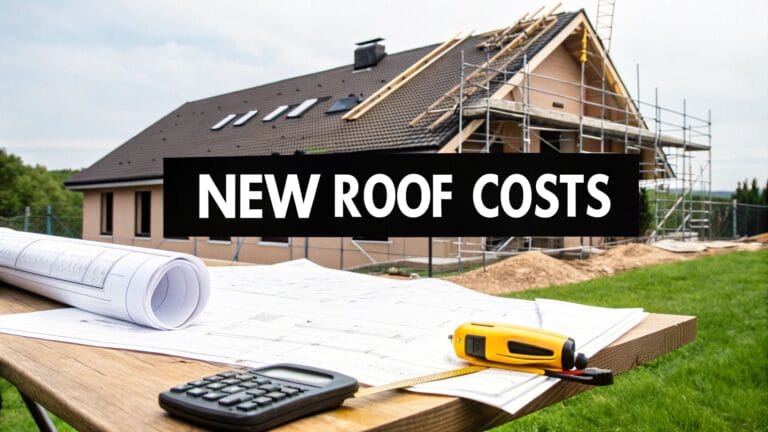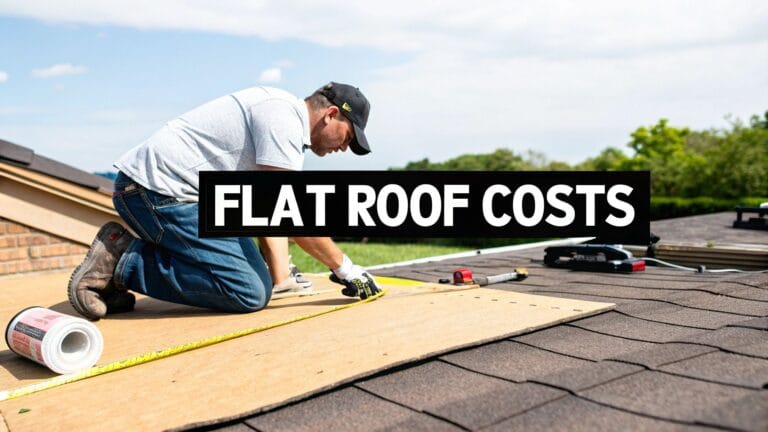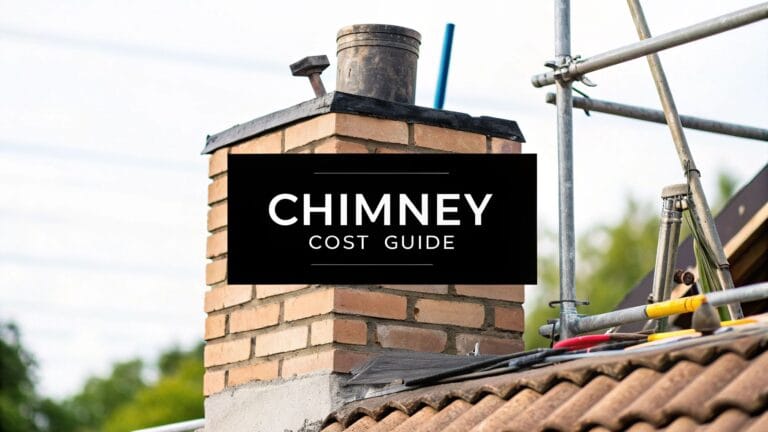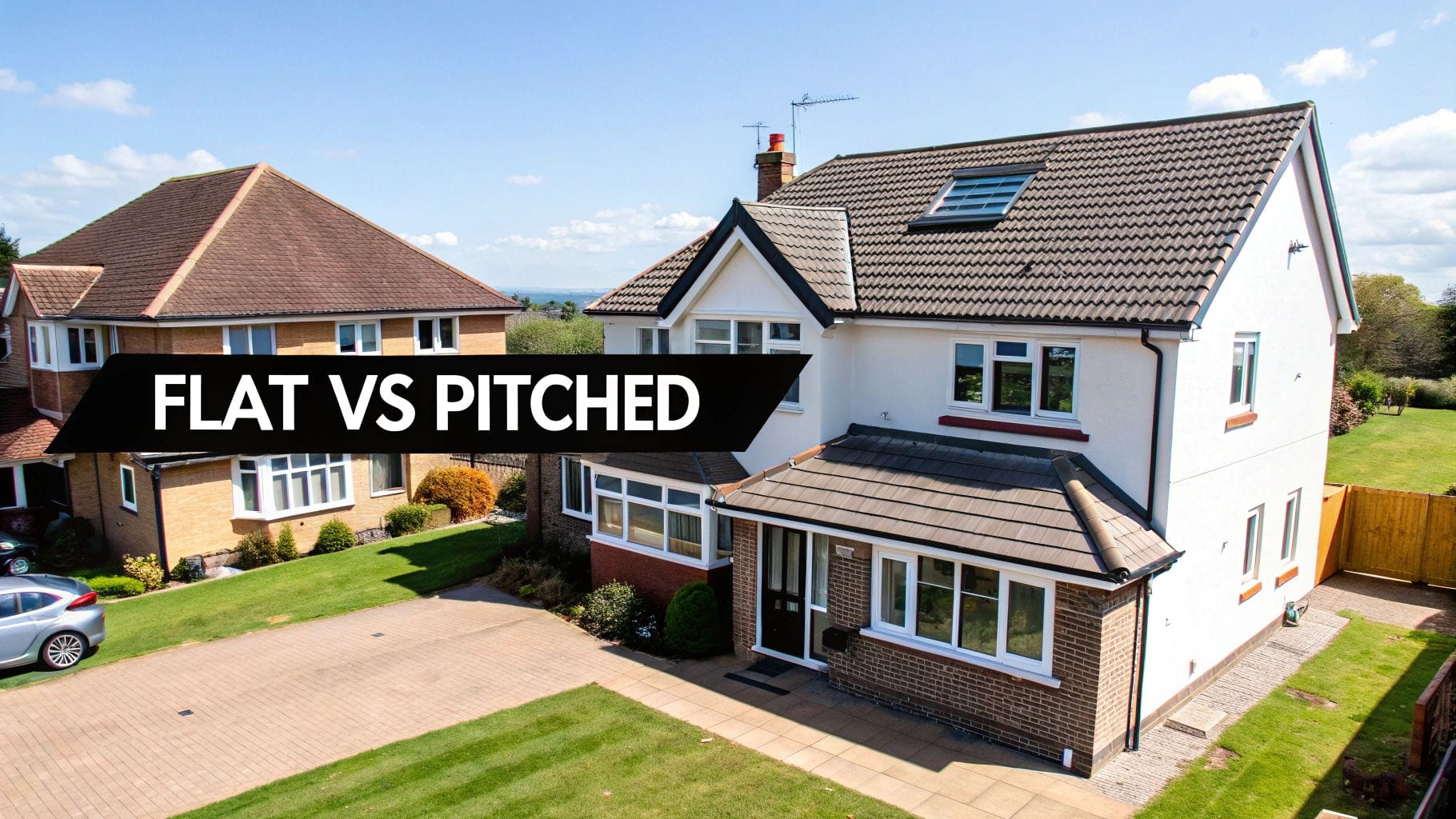
Flat Roof vs Pitched Roof: Which Is Best for Your UK Home?
Choosing between a flat roof vs pitched roof? Discover key factors like cost, durability, and style to help you make the right decision for your property.
At their core, the two main roofing styles come down to a simple trade-off. Flat roofs give you that clean, modern look and are often cheaper to install, which is why they’re so popular for extensions, garages, and commercial buildings across the UK. On the other hand, pitched roofs have stood the test of time, offering fantastic longevity and natural, fuss-free drainage—the go-to choice for traditional British homes for centuries.
Choosing Your Roof: A Core UK Property Decision
Picking between a flat or a pitched roof is one of the biggest decisions you'll make for your property. It’s about more than just kerb appeal; it impacts everything from long-term maintenance bills to your home's overall performance, especially with our notoriously wet British weather. For anyone owning property in the UK, getting this choice right is fundamental to protecting your investment.
Think about it this way: a sharp, contemporary extension almost demands the minimalist lines of a flat roof to complete the look. In contrast, a classic countryside cottage or a suburban semi would look incomplete without the familiar, sloping shape of a pitched roof, which is designed to handle rain effortlessly.
To really get to grips with what works best for you, a side-by-side look is invaluable. We cover the technical details in our guide on what a flat roof is, but the table below gives a quick overview of the key differences.
Quick Comparison: Flat Roof vs Pitched Roof
Here’s a straightforward summary comparing the essential characteristics of flat and pitched roofs for properties here in the UK.
| Feature | Flat Roof | Pitched Roof |
|---|---|---|
| Initial Cost | Lower | Higher |
| Typical Lifespan | 15-30 years (material dependent) | 50+ years |
| Maintenance | Regular checks needed for drainage | Less frequent checks for tiles/slates |
| Useable Space | Potential for roof terrace or garden | Potential for loft conversion/attic |
| Drainage | Relies on engineered drainage systems | Excellent natural water run-off |
| Aesthetics | Modern, minimalist | Traditional, classic |
This table makes it clear that there's no single "best" roof—it's all about what's right for your specific situation.
Key Takeaway: The best roof is entirely situational. A flat roof's lower upfront cost might be perfect for a garage or extension budget, while a pitched roof's longevity represents a better long-term investment for the main structure of a family home.
Ultimately, your choice hangs on your project, budget, and what you want from your home in the years to come. Whether you're planning a new build, adding an extension, or replacing an old roof, understanding these core differences is the first step. Our team at Evershield Roofing guides UK clients through this process every day, making sure the roof they choose is a perfect match for their home and their vision.
Comparing Upfront Costs and Long-Term Value
When you’re weighing up a flat roof against a pitched one, money is almost always the first thing that comes to mind. It’s easy to focus on the initial bill, but that’s only half the story. To get the full picture, you need to think about the long haul—what will maintenance, repairs, and an eventual replacement cost you down the line? A roof is a massive investment, so getting the balance right between upfront savings and long-term value is crucial.
For many UK property owners, especially when planning extensions or building garages, the lower initial cost of a flat roof is a huge draw. The construction is simpler, it takes less time to install, and the materials are generally more affordable. It's a combination that almost always makes it the cheaper option to get started.
Analysing the Initial Installation Costs
The difference in upfront cost isn't trivial. Here in the UK, flat roofs are consistently less expensive to install than their pitched counterparts. Let's take a practical example: a typical 20m² single-storey extension.
- A flat roof using a modern EPDM rubber system would likely cost between £2,000 and £3,000.
- A pitched roof for the same extension using standard concrete tiles could cost from £4,000 to £6,000.
That’s a significant saving you could put towards other parts of your renovation.
If we break it down by the square metre, the gap is just as clear. Flat roofs typically cost between £50 and £110 per m², depending on the material you choose. A traditional felt roof might be around £65 per m², whereas a modern, high-performance system like EPDM rubber will land somewhere between £80 and £100 per m².
Pitched roofs, on the other hand, start at £120 per m² for standard concrete tiles and can soar to £275 per m² or even higher if you opt for premium materials like natural slate.
This image gives a great overview of the key points to consider for a modern flat roof.
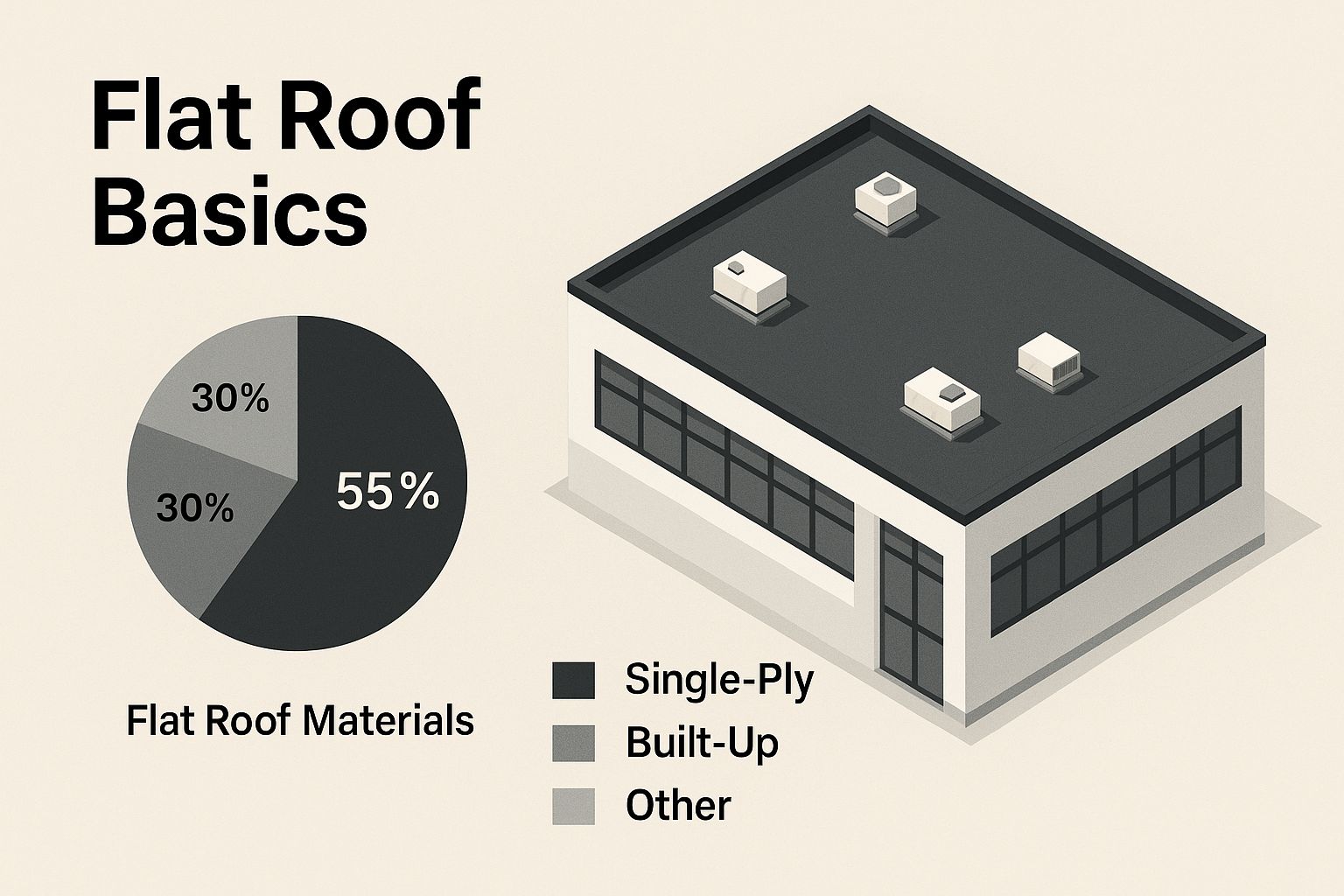
As you can see, the clean, modern look of a flat roof is backed by some very practical, budget-friendly installation costs, making it a natural choice for many contemporary UK projects.
Long-Term Value and Return on Investment
While a flat roof wins hands-down on the initial price tag, the conversation starts to change when we look at long-term value. A well-built pitched roof, using quality tiles or slates, can easily last 50 to 100 years, sometimes even longer. Its incredible durability means it can genuinely be a "fit and forget" solution for generations, making it a fantastic long-term investment in your property's structural integrity.
That said, modern flat roofing systems have closed the lifespan gap significantly. The old felt systems from decades past gave flat roofs a reputation for failing quickly, but today’s materials are a world apart.
- EPDM Rubber: With a professional installation from a specialist like Evershield Roofing, these can last for up to 50 years.
- GRP Fibreglass: This creates a tough, seamless surface that typically offers a lifespan of around 25-30 years.
- Single-Ply Membranes: These are durable, flexible solutions that will often last for 20-35 years.
Expert Insight: The real value isn't just in the material itself, but in the quality of the installation. I’ve seen poorly installed pitched roofs fail far sooner than a professionally fitted EPDM flat roof. At Evershield Roofing, our Firestone-approved technicians are trained to install every system meticulously to ensure it delivers its maximum lifespan and performance across the UK.
Lifespan has a direct impact on repair costs. A pitched roof might only need a few tiles replaced over its entire life. A flat roof does need more regular checks to ensure drainage is clear and the surface is sound, but modern systems are exceptionally resilient. To get a real sense of what to expect, take a look at our detailed guide on how long a flat roof lasts. Understanding this helps you calculate the true cost of ownership over decades.
Ultimately, your choice really hinges on your priorities. If you're building an extension and the budget is tight, a flat roof offers immediate, tangible savings. But if this is your "forever home" and you want maximum durability with minimal fuss in the future, a pitched roof offers a level of long-term peace of mind that's hard to beat.
How Each Roof Type Handles the UK Climate
When you’re weighing up a flat roof versus a pitched one, how it stands up to our famously unpredictable UK weather is a massive part of the decision. We get everything from persistent drizzle to heavy snowfall and high winds, and your roof is the first line of defence. Understanding how each style copes is essential for making a smart investment.
For centuries, the traditional pitched roof has been the go-to for British homes, and for one very simple reason: gravity. Its slope is a masterpiece of passive design, effortlessly shedding rainwater and stopping snow from piling up and putting a strain on the structure. This natural drainage is its greatest asset, really only needing clear gutters to do its job perfectly.
But let's be clear: the notion that a flat roof can't handle the British climate is completely outdated. Modern materials and expert installation techniques have revolutionised their performance. A professionally fitted flat roof from a team like Evershield Roofing is an engineered system, built from the ground up to manage water and provide a durable, reliable covering for any UK property.
Weather Resilience and Material Durability
The lifespan of any roof comes down to how well it withstands constant exposure to the elements. For a pitched roof, its strength lies in the overlapping tiles or slates, which create a formidable barrier against even wind-driven rain.
A flat roof works differently, relying on a single, continuous, and impermeable membrane to keep water out. This is where your choice of material becomes absolutely crucial.
- EPDM (Ethylene Propylene Diene Monomer): This is a high-performance rubber membrane that’s exceptionally tough against UV radiation and temperature swings. It won't crack or go brittle over time, making it a fantastic long-term solution for the UK’s climate.
- GRP (Glass Reinforced Plastic): Often called fibreglass, GRP creates a seamless, rock-solid surface that is completely waterproof. It's also robust enough to handle being walked on, which is a huge plus for maintenance or if you're planning a balcony.
Our Commitment to Quality: At Evershield Roofing, we know a flat roof is only as good as the hands that fit it. Our technicians are Firestone-approved experts in installing EPDM systems, which means every seam is flawlessly sealed and the drainage is spot-on. This meticulous approach is our guarantee that your roof will perform exactly as designed, protecting your UK home for decades to come.
Lifespan and Drainage in the UK Context
A roof’s longevity is a direct result of its design and the materials used. In the UK, our climate heavily influences this choice. With a typical slope between 30 and 50 degrees, pitched roofs are the historical favourites precisely because they handle rain and snow so well. While a flat roof won’t accumulate snow in the same way, it needs carefully planned drainage to prevent water from ‘ponding’—a real risk with our persistent rainfall. Find out more about the nuances of roof design considerations at Designing Buildings.
This brings us to a key point in the flat vs. pitched roof debate: drainage. A pitched roof does it passively. A flat roof, on the other hand, needs a proactive system. It’s built with a very slight, almost imperceptible ‘fall’ that guides water towards specific outlets. When an expert installs it, this system is incredibly effective.
So, how do the materials stack up? The table below gives a clearer picture of what you can expect in the UK.
Material Lifespan and Weather Performance
The material you choose is the single biggest factor in your roof's long-term performance. This table breaks down the most common options we see across the UK, comparing their expected lifespan and how they cope with our rain and occasional snow.
| Material | Typical Lifespan (Years) | Rain/Snow Shedding Efficiency | Best Use Case |
|---|---|---|---|
| EPDM Rubber | 40-50 | Excellent (with proper drainage) | Modern extensions, commercial properties |
| GRP Fibreglass | 25-30 | Excellent (seamless surface) | Complex shapes, balconies, terraces |
| Concrete Tiles | 50-60 | Excellent (natural slope) | Most residential homes, new builds |
| Natural Slate | 100+ | Superior (natural slope) | Period properties, high-end homes |
Ultimately, whether you lean towards the classic reliability of a pitched roof or the sleek resilience of a modern flat roof, the secret to surviving the UK climate is quality. A premium material installed by a skilled professional is the best defence you can have, ensuring your home stays warm, dry, and protected for years to come.
Understanding Maintenance and Repair Demands
The upfront cost and weather performance are big factors, but the long-term commitment to maintenance is where your choice of roof really hits home. A roof isn't a one-and-done purchase; it's an ongoing responsibility. Understanding the specific upkeep each type demands is absolutely vital for budgeting your time and money over the decades you'll own your property.

Ultimately, the main difference in upkeep boils down to two things: accessibility and drainage. A flat roof, being almost level, is far easier and safer for a professional to walk on, making inspections a pretty straightforward job. A pitched roof, on the other hand, presents obvious safety challenges and requires specialist equipment for even the most basic checks.
Flat Roof Maintenance: A Proactive Approach
Modern flat roofs are incredibly resilient, but their design demands a proactive approach to care. Because they don't have a steep slope to naturally shift leaves and rain, they need more frequent attention to stop problems from developing in the first place.
Regular inspections are the key, ideally twice a year in spring and autumn. This isn't complicated stuff; it's just about being consistent.
- Clearing Debris: Getting rid of leaves, twigs, moss, and anything else that might block the drainage outlets.
- Checking Drainage: Making absolutely sure that gutters and downpipes are clear to prevent water from pooling on the roof surface.
- Surface Inspection: Looking for early signs of blistering, cracking, or any physical damage to the waterproof membrane.
This routine care is simple but non-negotiable. Here at Evershield Roofing, we handle these checks for countless UK clients, catching small issues before they snowball into expensive repairs.
For a flat roof, maintenance is all about prevention. Keeping the drainage clear is the single most important task. A small blockage can quickly lead to standing water, which is the number one cause of premature wear and leaks.
Pitched Roof Maintenance: A Reactive Reality
Pitched roofs often get a reputation for being "low maintenance," but that's a bit of a misconception. It's true they don't need the same regular debris clearing as a flat roof, but when problems do arise, they tend to be more sudden and usually require immediate, professional repair.
Maintenance here is more about periodic visual checks, often done from the ground with a good pair of binoculars. You’re looking for:
- Slipped or Cracked Tiles: High winds and general ageing can easily dislodge tiles, creating a clear entry point for rainwater.
- Ridge and Hip Damage: The mortar holding the ridge tiles in place can crumble over time, weakening the entire roof structure.
- Gutter Blockages: It might happen less often, but blocked gutters can still cause water to overflow and seep into the eaves.
When a tile slips or mortar fails on a pitched roof, the repair is often urgent and far more complex due to the safety risks of working at height. Trying to find a perfect match for an older, weathered tile can also turn into a real headache.
For a complete rundown of what to look out for, take a look at our essential roofing maintenance tips, which cover both roof types in detail. The choice really comes down to this: the proactive, routine checks of a flat roof versus the more reactive, urgent repairs of a pitched roof. That difference truly defines the long-term experience of owning either one.
Using Your Roof for Design and Extra Space
Choosing a roof isn't just about keeping your property dry. It's a decision that fundamentally shapes your home’s character and how you can actually live in it. The whole flat-versus-pitched debate goes way beyond function; it gets right to the heart of your home’s aesthetic and its practical potential.
In the UK, the look of a home is often just as important as its layout. Pitched roofs are the very definition of classic British architecture, giving a property that timeless, familiar silhouette. But the appeal isn't purely visual – it's what a pitched roof allows you to do inside that makes it so compelling.
Creating Space with Pitched Roofs
The biggest win for a pitched roof is the bonus space it creates right under the rafters. That natural slope carves out an attic just waiting to be put to good use.
- Loft Conversions: This is the obvious one, but for good reason. Turning that dusty attic into a new bedroom, a quiet home office, or a playroom is a game-changer. Given UK property values, a well-executed loft conversion adds significant value and square footage without needing to build outwards.
- Vaulted Ceilings: For extensions or even main living areas, you can choose to leave the roof structure exposed. This creates stunning vaulted ceilings that make a room feel incredibly spacious, airy, and bright. It’s a real statement feature.
- Dormer Windows: Adding dormers doesn't just look great from the kerb; it floods the new space with natural light, turning a dark attic into a genuinely liveable room.
This potential for internal expansion makes a pitched roof a smart, strategic investment, especially for growing families or anyone with an eye on their property's long-term value.
Unlocking Potential with Flat Roofs
While pitched roofs expand your home's interior, flat roofs offer something different entirely: they give you usable space outside. The clean, minimalist look is a big draw for modern designs, but the real magic is what you can build on top.
A flat roof isn't just a covering; it's a platform. It offers a unique opportunity to reclaim outdoor space, which is especially valuable in built-up areas where gardens might be on the smaller side. This versatility is a key reason for their growing popularity on modern UK extensions.
When properly constructed by a specialist team like ours at Evershield Roofing, a flat roof can become a fantastic, functional part of your home.
- Roof Terraces and Balconies: That flat roof over your new extension or garage? It could easily become a private sun trap or an alfresco dining spot, giving you a peaceful escape with a view.
- Green Roofs: A 'living roof' planted with sedum or wildflowers looks incredible. More than that, it helps insulate your home, improves local air quality, and gives a welcome boost to biodiversity.
- Ideal for Solar Panels: You could argue that flat roofs are the perfect base for solar panels. They can be mounted on frames angled precisely towards the sun for maximum efficiency, no matter which way your house faces.
Ultimately, your roof is one of your property's most defining features. Whether you lean towards the traditional charm and interior space of a pitched roof or the modern versatility of a flat one, our team has the experience to guide you and deliver a build that brings your vision to life.
Making the Right Choice for Your UK Property

So, how do you decide between a flat and a pitched roof? It really boils down to your specific project, the character of your property, and what you want in the long run. There's no single right answer; the best choice for a modern extension in London might be completely wrong for a period cottage in the Cotswolds.
Let's think about a common scenario. Imagine you're adding a single-storey extension to a semi-detached house. In this case, a flat roof often makes the most sense. Its clean, horizontal lines blend seamlessly with contemporary designs, and the lower installation cost can free up a significant portion of your budget. Even better, it gives you the option to create a rooftop terrace—a brilliant way to gain outdoor space if your garden is on the smaller side.
Recommendations for Your Project
To make things clearer, let's look at the types of projects we see every day across the UK and which roof tends to work best.
Modern Extensions & New Builds: A flat roof is often the go-to choice here. Its minimalist aesthetic is a perfect match for contemporary architecture. Plus, it opens up possibilities for eco-friendly features like a green sedum roof or a discreet and efficient solar panel installation.
Traditional Homes & Loft Conversions: For period properties or anyone looking to convert their loft, a pitched roof is almost always the answer. It maintains the building's traditional character while providing the essential headroom and structural support needed to create valuable living space.
Garages & Outbuildings: In most cases, a flat roof is the most practical and budget-friendly solution for these structures. The installation is straightforward and material costs are lower, making it ideal for functional buildings where intricate design isn't a priority.
Key Consideration: Your decision is a trade-off between your immediate budget and your long-term plans. A flat roof offers modern flexibility and saves you money upfront. A pitched roof, on the other hand, delivers classic kerb appeal and the potential to expand your home's interior footprint.
Ultimately, the best roof is one that’s perfectly suited to your property, installed with high-quality materials by a skilled team, and built to serve you well for decades.
Choosing correctly takes local knowledge and real technical expertise. For a professional consultation tailored to your UK property, budget, and vision, get in touch with our team at Evershield Roofing. We can provide a free, no-obligation survey and a transparent quote to help you get started on the right foot.
Your Questions Answered
Even after comparing the two, you probably have a few specific questions about which roof is right for your property. Here are some straightforward answers to the queries we hear most often from homeowners across the UK.
Which Roof Is Better for Installing Solar Panels in the UK?
While you can fit solar panels on either type of roof, a flat roof often gives you a real edge. The panels are installed on angled frames, meaning we can position them to face the sun perfectly—no matter which way your house is oriented. That control is the secret to getting the most energy out of your system.
A pitched roof can be great for solar too, but you’re at the mercy of its direction. If it already has a south-facing slope, you’re in luck. If it faces east or west, your panels won't perform as well, and a north-facing roof is generally a non-starter. For pure solar efficiency, a flat roof gives you far more control.
Do I Need Planning Permission for a New Roof in the UK?
In most cases, no. If you're simply replacing your old roof with similar materials and not altering the structure, it usually falls under 'permitted development' rights. Think of it as routine maintenance.
However, if you're planning a major change—like swapping a pitched roof for a flat one, or vice-versa—you will almost certainly need to get planning permission. The same goes for raising the roofline. And if your home is a listed building or sits within a Conservation Area, the rules are much stricter.
Important Reminder: Before you commit to any major roofing work, a quick chat with your local council's planning department is essential. It’s a simple check that can save you a world of headaches and expense later on.
How Does Roof Choice Affect Home Insurance Premiums?
Insurers base their prices on risk, and historically, some viewed old-style felt flat roofs as more prone to leaks, which could push up your premium. Thankfully, that perception is changing as materials have improved.
Modern high-performance systems like EPDM rubber or GRP fibreglass are now recognised for their incredible durability, so most major UK insurers don't penalise them. A traditional pitched tile or slate roof is still generally considered the lowest-risk option. The best advice? Always be upfront about your roof type with your insurer and get quotes from a few different companies, as their policies can vary quite a bit.
Is a Warm Flat Roof Better Than a Cold One?
Without a doubt, yes. For virtually every home in the UK, a 'warm roof' is the superior design and the modern standard required by Building Regulations. With a warm roof, the insulation is placed on top of the roof deck, right under the waterproof layer. This keeps the entire roof structure at a stable, warm temperature.
The result is a far more energy-efficient roof. Crucially, it also stops condensation from forming inside the roof space, preventing the damp and rot that can plague older designs. A 'cold roof', which has insulation between the joists, leaves the structure above it cold and needs complex ventilation to work properly. For long-term performance and peace of mind, a warm roof is the only way to go.
Navigating these technical details is what we do best. For expert advice on the best roofing solution for your property, trust the professionals at Evershield Roofing. Contact us today for a free, no-obligation survey and a transparent quote to get your project started right. Find out more at https://www.evershieldroofing.co.uk.

